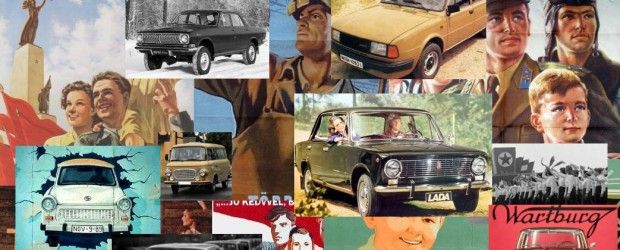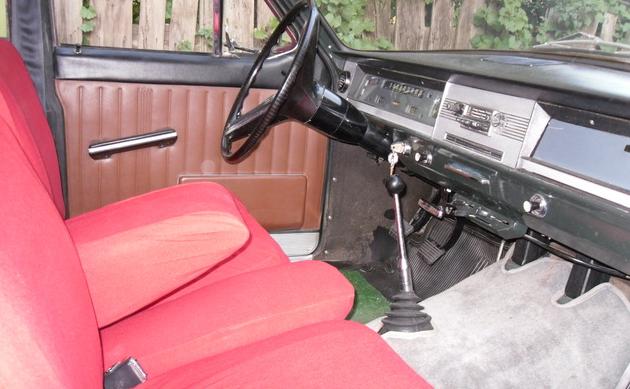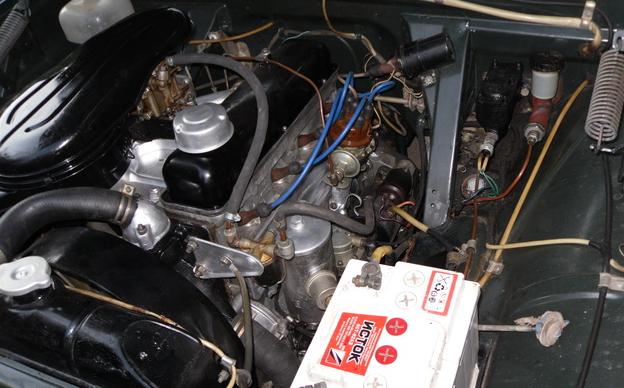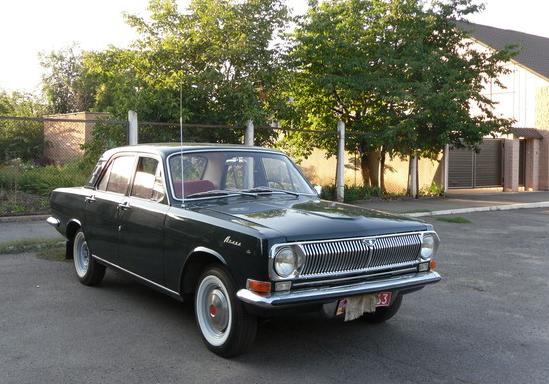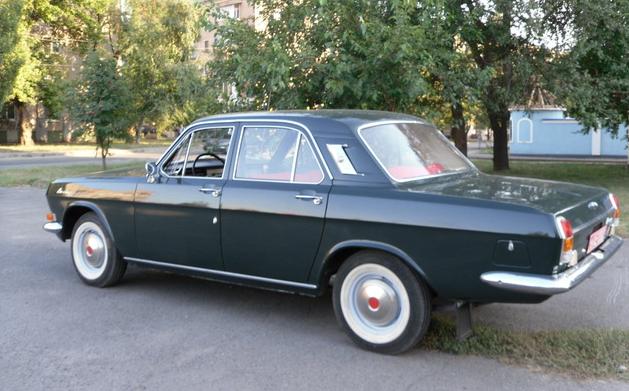|
Volga (Russian: Волга) is an automobile brand that originated in the Soviet Union to replace the venerated GAZ-M20 Pobeda in 1956. Modern in design, it became a symbol of higher status in the Soviet nomenklatura. Volga cars were also traditionally used as taxi cabs, road police interceptors, and ambulances (based on the estate versions). Four generations of Volga cars have been produced, each undergoing several updates during the production run.
First series—the GAZ-24 (1968-1985)Main article: GAZ-24
Design of GAZ-21s replacement began in early 1960s, and the first sketches showed a contoured body, as influenced by contemporary fashion. By 1965, the design has matured into the more angular and rigid profile that would eventually see production. Unlike the 21st Volga, the 24th was to introduce the economy of scale, a popular measure among most automotive producers, where the same body could house different powertrains, mechanics and interior trim, and hence could me marketed as separate cars (see platform sharing). GAZ hoped to employ this on the new Volga and a range was drawn where the entry model would carry the modernised four-cylinder unit, whilst the new top-level flagship would contain a six-cylinder engine with an automatic transmission. Unfortunately, for economic reasons the latter was removed from the production brief, despite promising test results from its prototypes in 1967. The first batch of 24 vehicles were assembled in 1968, 215 more followed in 1969 and the main conveyor in Gorky was launched in 1970.
Chronologically the car can be split into three major generations, the original GAZ-24 was produced from 1968 until 1985. The second generation includes a hand-assembled exclusive GAZ-3102 (1982-2009) and its cross-breeds with the GAZ-24, the GAZ-24-10 (1985-1992) and GAZ-31029 (1992-1997). The third and final generation includes the GAZ-3110 (1997-2004) and GAZ-31105 (2004-2009). These models are explained in their respective sections below, whilst the remaining of this section looks at the original GAZ-24. Like the GAZ-21 (and most Soviet-built cars), its exterior, though inspired by several foreign models, the 1970 Plymouth Valiant, the Mercedes-Benz W114 and the Volvo 140 in particular, was largely an indigenous product. Despite its more winder appearance, the GAZ-24 was in fact 75 mm shorter in length and 120 mm in height, yet its wheelbase was extended by 10 mm. The lower body waist line, allowed the window area was to be greatly increased along with interior space. The combination of this progressive design combined with a lower clearance gave it an elegant, light, yet more executive aura. Internally the car was powered by a new ZMZ-24D engine, a major upgrade over its predecessor. Though retaining the OHV configuration, it now ran on 92 RON gasoline. The new double-barrelled carburettor, with a higher compression ratio gave out 95 h.p. at 4500 rpm and an even more impressive 186.3 Nm of torque at 2200–2400 RPM. Transmission was now fully synchronised gearbox four on floor. Braking system was also new, with a hydraulic vacuum servo unit (a licence-built Girling PowerStop), as well as an independent parking brake (rather than transmission-based on the GAZ-21). At the same time, certain archaic features were retained for their reliability, like the kingpin front suspension and recirculating ball steering. (Power steering was to be standard on the six-cylinder engine model, but as explained above, this, as well as automatic transmission, were removed before production.)
The car was produced in several modifications, however these were now indicated by numbers rather than letters. The base sedan version was the GAZ-24. GAZ-24-01 was the taxi, which included an artificial leather interior and a slightly de-forced engine to run on 80 RON petrol. GAZ-24-02 was the estate. Though introduced later (1972), unlike the GAZ-22, it was serially built in parallel with the rest of the cars (though private ownership would remain a rare exception). Its cargo section featured a third folding row of seats in the rear. The second row, had two independent seats, that could be folded independently of each other. The rear, fifth, door was now a single unit that opened straight up instead of sideways. GAZ-24-03 was the ambulance version of the -02. GAZ-24-04 was the taxi estate, with the powerplant and interior trim of the -01. In 1977 a GAZ-24-07 conversion kit was introduced for taxiparks, that ran on natural gas. The GAZ-24-24 was the successor to the GAZ-23 "Chaser", with an identical V8 and automatic gearbox. This car however had even less features to differentiate it from standard vehicle. For example the automatic selector was masked under a standard shifting lever. A small batch of export cars for countries with left-hand traffic was called GAZ-24-54 (less than a thousand examples built). GAZ-24-76 and -77 were export versions to Benelux countries, who would retrofit the cars with Peugeot Indénor diesels and a more luxurious trim such as vinyl roof. Five experimental vehicles were built on the chassis of GAZ-69 4x4, called GAZ-24-95, one was known to be personally used by Leonid Brezhnev.
Though the vehicle never underwent a generational facelift on the scale of the GAZ-21 (if one does not count its derivative successors), nonetheless the car was modernised during production. In early production years changes included removal of bonnet-mounted rear-view mirrors, new ignition and boot locks. The novel belt-speedometer proved too complicated and was replaced by a standard arrow-driven one, as was the fate of the engine cooling coupling that controlled the ventilator (proved unreliable, the ventilator would be permanently on, whilst warm air for cold starts would be manually controlled with Venetian-type shutter). Additions included external comfort lights were on the rear pillars chrome element, that turned on upon the opening of rear doors. In the original design brief the GAZ-24 was to be retired by 1978, however, by the early 1970s, work on the successor was to be a deep modernisation. Even so, the stagnation effects meant that the planned replacement project (see GAZ-3102 below) was not given its timely go-ahead. Hence, in 1977 GAZ was only able to carry out a small modernisation to the whole range. Visually, these Volgas can be identified by bumper overriders on front and rear, front fog lights and rear reflectors integrated into a single block. Inside the car gained retractable seat belts, a new dashboard where all exposed metal elements were covered by plastic. In this final shape the car was produced until 1985, the estate until 1987. Including the GAZ-24-10 (see below) almost one and a half million such Volgas were produced.
Overall the original 24th Volga was a major success. Like the GAZ-21 it remained a dream car for the Soviet public. However, unlike the GAZ-21 it cost almost twice as much, and given that its launch coincided with the launch of the VAZ plant, the more available Lada allowed for the Volga to rise in exclusivity. The lions share of base model sedans were used for the ever-growing Soviet Nomenklatura, whist private ownership would often be offered only to representatives of Soviet public elite and celebrities. Given that it was an exception to see a Volga in open sale, its resale value would often be several times higher than the nominal price. Though even the latter would be well outside the financial abilities of the Soviet working class. Thus though the car was as iconic of its time as the predecessor, it was also become a symbolic feature of Social stratification in the USSR, and the Era of Stagnation during which it was produced. This more negative connotation began to disperse following the introduction of the GAZ-3102. Whereas the GAZ-21 became a youngtimer collectible by the Soviet Unions collapse, the GAZ-24th extended conveyor life meant that only in the late 2000s have prices for low-mileage mint-condition models and restoration interest began to climb.
|
||||||||||||||||
